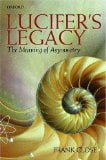 Lucifer’s Legacy: The Meaning of Asymmetry
Lucifer’s Legacy: The Meaning of Asymmetry
by Frank Close
Oxford University Press, £8.99, ISBN 019866267X
Lucifer’s Legacy is as much a history of particle physics as it is a description of symmetry and asymmetry in the universe. The book has its origins in the Tuileries Gardens in Paris when the author, Frank Close, noticed the otherwise perfect symmetry of the parks was broken by a headless statue of a devil, the Lucifer of the title. From here, Close sets off on a metaphorical journey in search of a unified, perfectly symmetrical physical universe.
It is a slightly contrived starting point but he rapidly leaves it behind and launches into one of the most enjoyable romps through the history of sub-atomic physics I’ve read. He pulls together some of the best stories: the Curies’ purification of radioactive elements; Henri Becquerel’s work on X-rays and JJ Thomson’s discovery of the electron, and he tells them well. He has an easy way with metaphor and I found myself understanding again concepts that I already thought I knew. My only quibble was with the biological aspects of asymmetry. Close is not a biologist and sometimes that showed. For example, at one point he describes DNA bases as amino acids (they’re not) and says that amino acids link together via their side chains (they don’t). But I suspect that only a picky ex-biochemist like me will be bothered by these very minor errors.
The second half of the book gets to grips with the concept of symmetry in physics and in particular the unification of the four forces of gravity, electromagnetism, strong nuclear, and weak nuclear. Once again, Close’s easy writing style and eye for metaphor makes these difficult concepts accessible and I came away with a clear vision of how and why modern physics is trying so hard to create a Grand Unified Theory of Everything.
I read this book on the train and was regularly disappointed when my short daily journeys ended. However, public reading also led to one of my more unusual commuting experiences. Many people took a second glance at the title but one woman stared in horror as she realised what I was reading. She had a Bible open on her lap and spent the rest of the journey peering at me as if she expected me to grow horns.
The book offers very little in the way of answers, which I found a relief both because science is more about questions than answers and also because those answers are simply not available. I would recommend this to anyone who has even a passing interest in why modern particle physics has evolved to its current state. It’s also a good book to offer to anyone who wants a clear summary of some of the most important discoveries in physics; most of them are there.
My final thought comes from the second paragraph of the book in which Close declares that he is not going to write a “seamy [sic] pot boiler”. Even though Lucifer’s Legacy is a good read I have to report that this is not a Jackie Collins bonkbuster. But what’s been bothering me for days is this; Close is a physicist so surely he realises that if a pot boils it steams?



